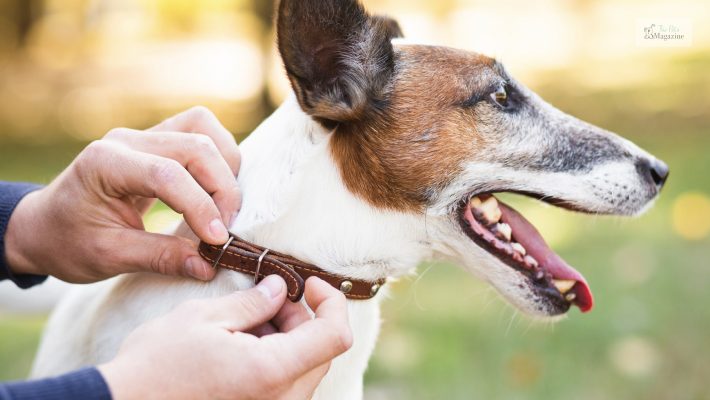How To Use Flea Collars For Dogs? And its Alternatives


Is your dog scratching itself a lot for the last few days, isn’t showing any interest in eating and/or acting restless or lethargic suddenly? These symptoms generally point towards flea and tick infestation, which is one of the most common and bothersome issues that affect our canine companions.
These tiny parasites cause a great deal of discomfort and can even lead to serious health problems for our four pawed family members if left untreated. That’s why it’s important to learn about and invest in preventive measures such as flea collars for dogs.
In this article, we will explore the importance of protecting your dog from fleas and ticks and the effectiveness of flea collars for dogs. From understanding how they work to the different types available; we will cover it all. So, let’s get started and ensure your four-legged friend stays happy, healthy, and flea-free!
Importance of Flea and Tick Prevention for Dogs

Flea and tick prevention for dogs is crucial for several reasons. We have explained these reasons in detail below:
Preventing Infestations
Fleas and ticks are common parasites that can infest dogs and cause a range of health problems. Fleas can quickly multiply in numbers and lead to an infestation not only on the dog but also in the surrounding environment, such as your home.
Dogs can catch fleas in many ways. These include while playing or walking on the grass in your backyard or at the dog park and coming into close contact with a flea-infested dog.
Tick infestations can happen when dogs are exposed to areas where ticks are prevalent, such as wooded areas or tall grass. Regular use of preventive measures can help keep these parasites at bay and prevent infestations.
Protection Against Diseases
Fleas and ticks are known carriers of various diseases that can be transmitted to dogs. Fleas can transmit diseases like flea allergy dermatitis, Bartonella (cat scratch fever), and tapeworm infections.
Ticks can transmit dangerous diseases such as Lyme disease, Rocky Mountain spotted fever, Ehrlichiosis, and Anaplasmosis.
These diseases can cause severe illness and even be life-threatening to dogs. By adopting measures to prevent flea and tick infestations in pets, you significantly reduce the risk of your dog contracting these diseases.
Reducing Discomfort and Itching
Fleas are notorious for causing intense itching and discomfort in dogs. When dogs are infested with fleas, they may scratch excessively, leading to skin irritation, hair loss, and secondary infections.
Ticks, on the other hand, attach themselves to the dog’s skin and feed on their blood. This can cause irritation, inflammation, and potential allergic reactions. By using preventive measures, you can help minimize the discomfort and itching associated with flea and tick bites.
Preventing Transference to Humans
Fleas and ticks not only pose a risk to dogs but can also affect humans. When fleas bite humans, it causes itchy red bumps and potentially transmits certain diseases. Similarly, ticks also latch onto humans and transmit diseases like Lyme disease and other tick-borne illnesses.
By keeping your dog protected from fleas and ticks, you also reduce the risk of these parasites hitchhiking on your pet and entering your home, thereby lowering the chances of human exposure.
It’s important to consult with your veterinarian to determine the most suitable flea and tick prevention and treatment methods for your dog. Options may include topical treatments, oral medications, flea collars, or a combination of these.
Regular and consistent use of these preventive measures is essential to effectively protect your dog from the harmful effects of fleas and ticks.
Are Flea Collars for Dogs Effective?
Before we move on to discuss whether flea collars for dogs are effective or not, let’s first understand what dog flea collars are and how do they work. It is a specialized collar designed to prevent flea and tick infestation on dogs. Flea collars for dogs perform two main functions. These are –
- Repelling Flea and Ticks
- Killing Fleas and ticks and treating infestation
Based on these functions, there are mainly two types of dog flea collars found in the market. One type of collar emits gas or toxin that prevents fleas or ticks from coming near your dog’s fur. Hence this type of collar only works when the fleas and ticks are in proximity.
Another type of collars continuously releases active ingredients into your dog’s coat to repulse and kill fleas for a certain duration. The material of the collar acts as a storage for the flea-repellant ingredient.
When your dog wears a flea collar, the active ingredients start to spread across their fur via the natural oils present in the coat and skin of dogs, thereby creating a protective layer. Fleas or ticks that come near the collar or your dog’s fur are repelled or killed because of this protective barrier, effectively preventing infestations.
The active ingredients used in flea collars can vary, but the most common ones include insecticides like imidacloprid, flumethrin, or deltamethrin. These ingredients are embedded or infused into the collar, allowing them to slowly release over time.
Dog flea collars come in various designs and are made with different materials, each offering unique features and benefits. Some collars are adjustable, while others are designed to be worn for a specific period. Regardless of the type, the primary purpose of a dog flea collar is to provide long-lasting protection against fleas.
Are Dog Flea Collars Effective?

There are several studies that suggest that flea collars can be quite effective in controlling and preventing flea and tick infestation in dogs. According to research carried out by School Of Veterinary Medicine, Purdue University, around 95% of fleas present on your dog’s skin can be killed or eliminated by using flea collars.
However, the effectiveness of flea collars for dogs depends a lot on factors such as surrounding environment, age, size, and breed of the dog. For instance, dogs with longer and thicker fur such as golden retrievers are at higher risk of flea infestation compared to dogs with shorter coats. This is mainly because it is easy for fleas and ticks to latch onto and hide inside longer and thicker fur.
Hence dogs with thick and long fur such as Bernese Mountain dog, Samoyed, Husky required more potent flea collars.
Benefits of Flea Collars For Dogs

Using a dog flea collar offers several benefits in the prevention and control of flea infestations compared to other preventive measures. Here are some advantages of using a dog flea collar:
Continuous Protection
Flea collars provide long-lasting protection against fleas for a specific period. Once you put the collar on your dog, it releases active ingredients that repel and kill fleas. Unlike spot-on treatments or oral medications that require regular application or administration, flea collars provide continuous protection for several months, depending on the specific product.
Convenience
Flea collars are easy to use and require minimal effort. You simply need to secure the collar around your dog’s neck, and it will start working. There’s no need for monthly applications or remembering to administer medication at specific intervals. Once the collar is on, it provides ongoing protection without additional steps.
Effective Flea Control
Many flea collars contain active ingredients that not only repel fleas but also kill them. These ingredients are slowly released from the collar and spread across your dog’s fur, creating a barrier that repels and kills fleas on contact. This helps prevent fleas from biting your dog and stops infestations from developing.
Cost-Effective
Compared to other flea prevention methods, such as spot-on treatments or oral medications, flea collars tend to be more cost-effective. While the initial cost of a flea collar may be higher, its long-lasting protection means you won’t need to purchase monthly treatments or refills as frequently. Over time, this can result in savings.
Reduced Environmental Contamination
Some flea collars not only protect your dog but also help control fleas in the surrounding environment. When your dog wears a flea collar, it can prevent fleas from infesting your home, as the collar’s active ingredients spread onto your dog’s fur and act as a barrier against fleas. This can reduce the overall flea population in your living space.
Safety
Flea collars are generally safe for use on dogs when used according to the manufacturer’s instructions. However, it’s important to choose a collar appropriate for your dog’s size and age and to follow any specific guidelines provided by the manufacturer. If you have multiple pets, make sure to use collars specifically designed for dogs, as some flea collars for dogs can be toxic to cats.
While flea collars can be effective in controlling fleas, it’s important to note that no single method is 100% foolproof. Flea collars may not be suitable for dogs with specific allergies or sensitivities, and some dogs may experience skin irritation or other adverse reactions. It’s always a good idea to consult with your veterinarian to determine the best flea prevention approach for your dog’s individual needs.
Common Misconceptions About Dog Flea Collars

There are several misconceptions surrounding dog flea collars that are important to address. Learning about these misconceptions will enable you to make informed decisions when buying flea collars for dogs. Here are some common misconceptions:
Flea Collars Are Toxic
All flea collars for dogs contain active ingredients that repel and kill fleas. Most of the times these active ingredients are neurotoxins. In small doses, they are only harmful for tiny insects like fleas and ticks. The small amounts of neurotoxins present in flea collars is quite safe for dogs when used as directed.
However, it’s essential to choose a flea collar specifically formulated for dogs and avoid using dog products on other pets, such as cats.
Some people also think that flea collars for dogs pose health risks for humans because of neurotoxins. This is not true. As we have mentioned above, flea collars for dogs contain very small amounts of neurotoxins which is not dangerous for humans in any way.
All Flea Collars Are The Same
A lot of pet parents believe that all dog flea collars are the same and perform the same function. But this is not true at all. Flea collars come in various formulations and designs, each offering different levels of effectiveness and duration of protection.
For instance, some flea collars for dogs contain natural active ingredients such as neem oil, lavender oil, citronella oil, eucalyptus oil, cedar oil and the like. These collars only repel fleas because the natural ingredients are not strong enough to kill the fleas and ticks.
Some collars are infused with synthetic active ingredients like pyriproxyfen, flumethrin, propoxur, deltamethrin, amitraz etc. These types of collars are highly effective at killing fleas and ticks.
Recently flea collars with embedded ultrasonic technology to repel fleas and collars are also becoming popular. This is because some pet parents believe that they are non-toxic and environment friendly. However, there is very little evidence suggesting that these collars are effective.
So, as we can see, each type of dog flea collar has its advantages and disadvantages. Hence, it’s important to research thoroughly beforehand and choose a flea collar that suits your dog’s specific needs.
Dog Flea Collars work instantly
While some fleas may be repelled or killed upon contact with the collar, it may take some time for the collar to distribute the active ingredients across your dog’s fur. So, it’s important to follow the recommended duration of use for optimal effectiveness.
Flea collars come in different sizes and designs to accommodate different breeds and sizes of dogs. It’s crucial to choose a collar that fits your dog properly to ensure maximum protection.
Alternate Preventive Measures for Flea & Tick
While dog flea collars are a popular and effective method of flea prevention, there are other flea control methods available too. These include:
Topical Treatments
Topical treatments are applied directly to your dog’s skin, usually between the shoulder blades. These treatments kill fleas on contact and provide month-long protection.
Oral Medications
Oral medications are ingested by your dog and work from the inside out. They target and kill fleas that bite your dog, preventing infestations.
Flea Shampoos
Flea shampoos are specially formulated to kill fleas on contact. They provide immediate relief for dogs with active flea infestations but offer limited long-term protection.
Wrapping Up
Protecting your furry friend from fleas is an essential part of responsible pet ownership. Flea infestations can cause discomfort, and health issues, and even impact your entire household. Investing in a dog flea collar is a simple yet effective way to prevent fleas and provide long-lasting protection for your pet.
By understanding how dog flea collars work, the different types available, and how to choose and use them properly, you can keep your dog happy, healthy, and free from the annoyance of fleas. So, don’t wait any longer—get your furry friend a dog flea collar today and enjoy a flea-free environment!








Leave A Comment